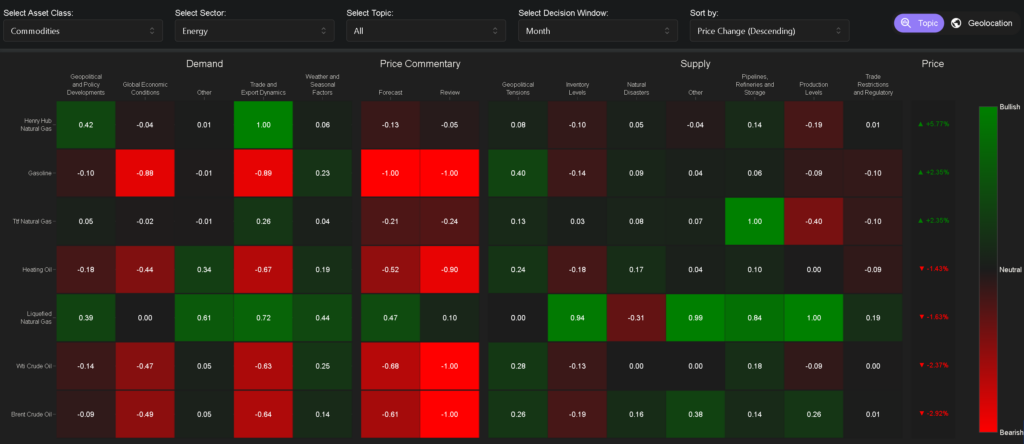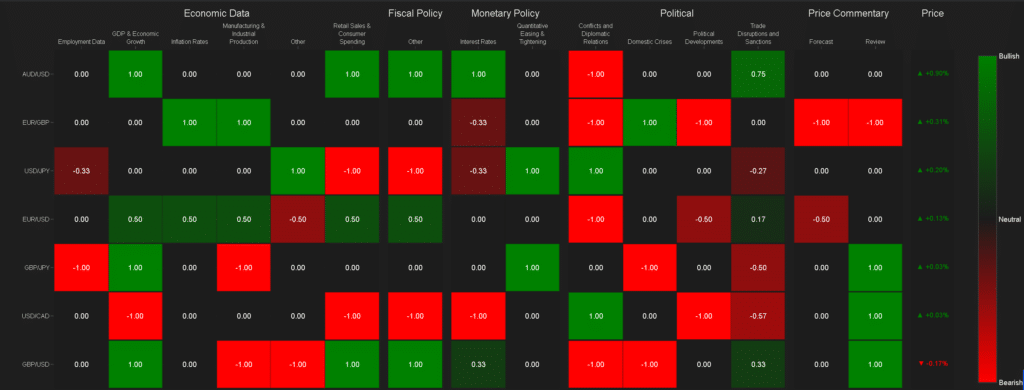*This article explains how institutional investors can navigate today’s complex market environment by leveraging AI-powered real-time analysis across five key macroeconomic themes affecting investor sentiment, aimed at portfolio managers and investment professionals seeking to transform market volatility into strategic advantage.
Navigating today’s chaotic markets is becoming increasingly similar to guiding a ship through stormy, unpredictable seas. Institutional investors face increased complexity as interconnected macroeconomic factors – such as inflation divergence, energy volatility, altering central bank policies, and geopolitical instability – continue to influence investor sentiment and asset prices. In this rapidly changing context, fast, actionable intelligence based on real-time data is key. Investors must grasp new macro signals – from inflationary tendencies and disruptions in oil supply to subtle variations in central bank rhetoric – and quickly transform these insights into tactical adjustments across currencies, commodities, and asset classes.
Our Trading Co-Pilot and Sector Analysis feature provides the exact toolkit required in these tumultuous times, turning massive amounts of market data – economic releases, geopolitical news, policy announcements, and real-time sentiment – into actionable market intelligence by using a proprietary LLMs. Instead of just providing raw data, our Trading Co-Pilot finds important correlations that actually affect asset values, enabling investors to take proactive measures. For example, tactical investment choices across pertinent asset classes can be made immediately in response to minor changes in governmental rhetoric or interruptions in energy output.
With the help of our Trading Co-Pilot’s real-time insights, here we examine five key macroeconomic topics that are currently affecting global markets and emphasise the consequences for different assets.
1. Global inflation divergence
Global inflation trends are becoming more polarised, especially between Europe and the United States. Due to a robust labour market and persistent consumer demand, core inflation pressures in the United States are still firmly high, hovering around 3%. On the other hand, as energy prices decline, Europe’s inflation dynamics are more benign and are relaxing towards the ECB’s objectives.
Our AI-powered real-time analytics show how this disparity affects currencies and commodities. The dollar is strengthened vs other currencies, such as the euro, by high inflation expectations in the United States, which are supported by steady economic development. Recent euro depreciation is evident from our currency heatmap data, as European economic growth indices fall short of robust U.S. benchmarks. In response, institutional investors have increased their allocation to commodities, infrastructure, and real assets connected to the United States that are expected to gain from further inflationary pressures.
2. Energy supply shocks and oil volatility
The energy industry is still quite vulnerable to geopolitical unpredictability and supply disruptions. Due to ongoing OPEC+ output limits and escalating geopolitical tensions in important production zones, our recent sentiment indicators for Brent crude oil and gasoline have become more bullish. In particular, real-time signals show that geopolitical concerns boosted bullish sentiment in Brent crude oil (+1.14%) and gasoline prices (+1.91%), highlighting how swiftly these factors show up in price movement.
The larger market is affected by these supply shocks. When oil prices rise, the currencies of countries that export energy, like the Canadian dollar, typically do well. To offset the bullish effects of rising oil prices, our recent data also points to subtle headwinds on the Canadian dollar brought on by worsening domestic economic indicators. Therefore, it is essential to react to these two factors in a dynamic manner, which emphasises the need of real-time sector insights.

Above: Macro trends across the energy complex as highlighted through our Trading Co-Pilot’s Sector Analysis feature
3. Central bank policy divergence
The recent complexity is increased by the different monetary policies of the main economies. The ECB is taking a more dovish attitude in light of worse economic statistics, while the Federal Reserve continues to retain a somewhat hawkish stance because of persistently high inflation. Bond and foreign exchange markets are becoming more volatile as a result of the Bank of Japan’s first tightening cycle in decades.
Significantly pessimistic sentiment associated with European policy easing is revealed by our real-time monetary policy signals, which has caused the Euro to decline (most recently by -0.02%). In contrast, the U.S. dollar, which benefits from comparatively higher interest rates, continues to rise amid domestic worries. Investors must quickly modify their currency hedging and duration strategies in reaction to central bank communications since these dynamics have a substantial impact on global bond yields, commodity prices, especially gold, and currency allocations.
4. Chinese demand recovery and industrial cycles
The Australian dollar and other currencies that are strongly linked to China’s demand profile are immediately impacted by the country’s economic trajectory and industrial commodities cycles. Recently, our data indicated persistent investor mistrust despite significant policy easing intended to revive China’s industrial sector. Moderately strengthening industrial demand signals support the moderate bullishness (+1.25%) of copper prices. On the other hand, there are substantial challenges facing the Australian dollar (-0.89% GDP and economic growth), which reflects skepticism about how strong China’s economic recovery will be.
In terms of strategy, monitoring Chinese economic indicators in real time – from changes in the real estate market to data on industrial production – offers priceless early warnings. Investors can modify their foreign exchange exposure in commodity-linked currencies and take proactive positions in commodities such as steel, copper, and iron ore with the use of these insights.

Above: Macro trends across the currency complex as highlighted through our Trading Co-Pilot’s Sector Analysis feature
5. Trade policy and tariff uncertainty
Currency and commodities markets are once again volatile and unclear due to the return of global trade disputes, particularly those between the United States and China or within NAFTA countries. Driven by ongoing diplomatic tensions and retaliatory tariff threats, our recent sentiment data shows increased bearish pressures in currencies vulnerable to trade disruptions, including the Chinese yuan and the Canadian dollar. The fragility of trade-connected currencies has been highlighted by the Mexican peso, which has also experienced volatility increases directly linked to statements about tariffs.
The ripple effects extend into commodities. Agricultural exports such as soybeans remain under pressure as China diversifies away from U.S. suppliers, while industrial metals are exposed to disruption risk from potential U.S. steel and aluminum tariffs. Our real-time AI-driven trade policy sentiment monitoring equips institutional investors with the foresight needed to hedge proactively or adjust exposures before headline-driven volatility emerges fully in market prices.
Strategic implications for institutional investors
Combining knowledge from these major themes demonstrates how institutional portfolio strategy can be radically changed by real-time macro intelligence by making it powerful for:
Active Currency Hedging: When optimistic commodities signals appear, investors might reduce their hedges on commodity-linked currencies, such as the Canadian or Australian dollar, or go short on the Euro or Yen in response to dovish central bank signals.
Dynamic Commodity Positioning: By enabling tactical adjustments across industrial commodities, precious metals, and energy assets, immediate notifications regarding supply disruptions or Chinese demand indications optimise sector allocation and risk management.
Tactical Macro Overlays: Using real-time insights into central bank divergences and geopolitical concerns, investors can strategically leverage FX pairs or modify equity and fixed-income exposures in response to changing inflation and growth signals.
Navigating complexity with sector intelligence
The macroeconomic landscape of today is particularly flexible and interrelated. Asset prices can be significantly impacted by even little changes in geopolitical opinion or economic policy, which can quickly ripple across markets. Using AI-powered, real-time insights, such as those offered by our Trading Co-Pilot’s Sector Analysis feature, enables institutional investors to precisely navigate uncertainty, take advantage of new opportunities, and manage risk proactively.
Using powerful AI-driven analytics is not only advantageous, but becoming more and more necessary in a time when market circumstances can change based on a single governmental announcement or geopolitical event. Ultimately, investors that possess the ability to continuously watch markets and the flexibility to react quickly are in a unique position to prosper in times of volatility, converting market complexity into a competitive advantage.
